2012 VOLKSWAGEN GOLF MK6 engine
[x] Cancel search: enginePage 275 of 516
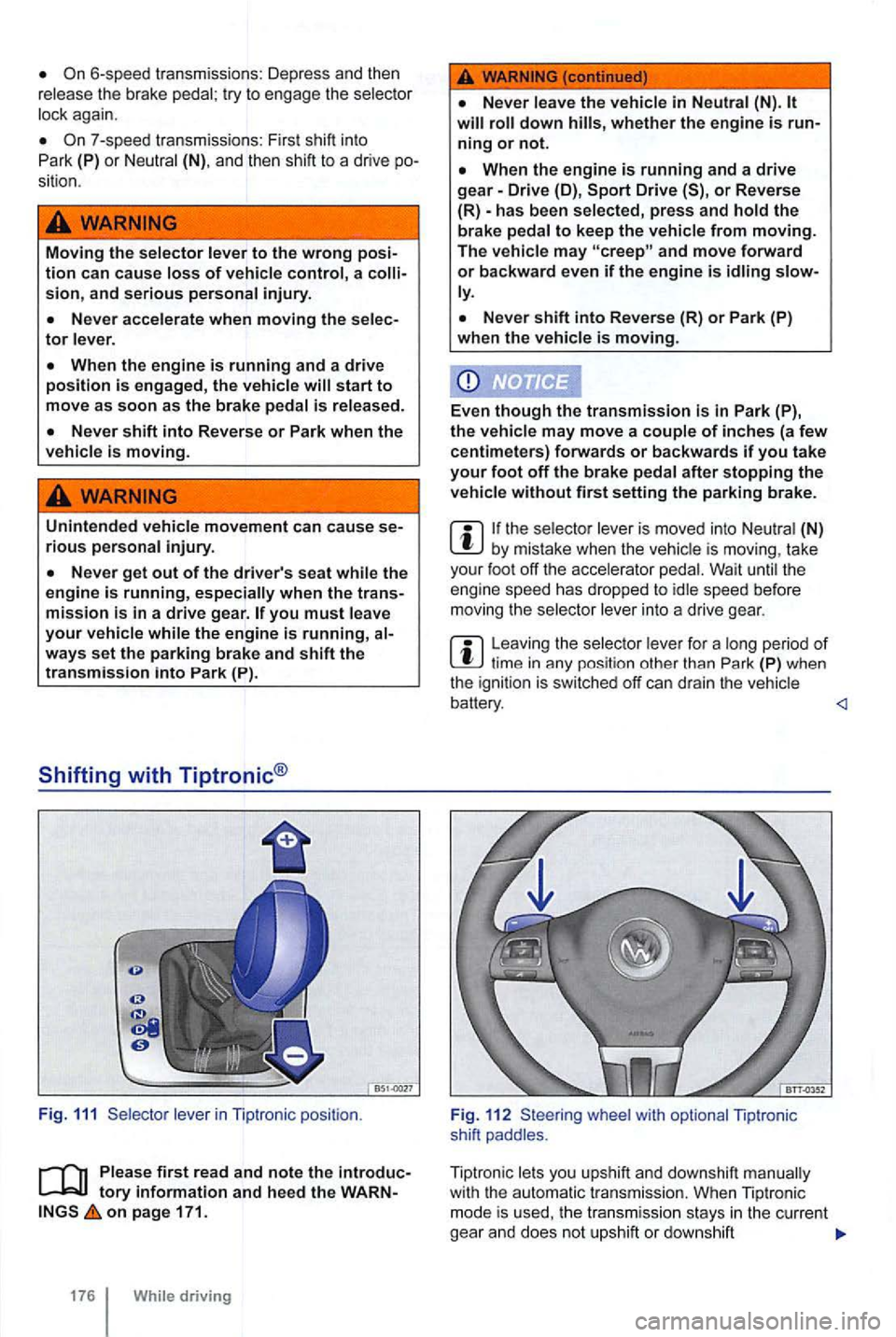
Moving the selector lever to the wrong posi-tion can cause loss of vehicle control, a co sion, and serious personal injury.
Unintended vehicle movement can cause se-rious personal injury.
you must leave your vehicle while the engine is running, al-ways set the parking brake and shift the transmission into Park (P).
Shifting with Tiptronic®
Fig . 111 lever in Tiptronic position.
Please first read and note the introduc
on page 171.
176 While driving
WARNING (continued )
will roll down hills, whether the engine is
When the engine is running and a drive gear-Drive (D), or Reverse
(R) -has been selected, press and hold the
brake pedal to keep the vehicle from moving.
The vehicle may and move forward or backward even if the engine is idling ly.
the selec tor lever is moved into Neutral (N) by mistake when the vehicle is moving , take
your foot off the accelerator pedal. Wait until the
engine speed has dropped to idle speed before
mov ing the selector lever into a drive gear.
Leaving the selector le ver for a long period of
whe el with optional Tiptronic
shift paddles .
Tiptronic lets yo u upshift and downshift manually
with
the a utomatic transm ission. When Tiptronic
mode is used, the transmi ssio n stays in the curren t
gea r and does not upshift or dow nshift
Page 276 of 516
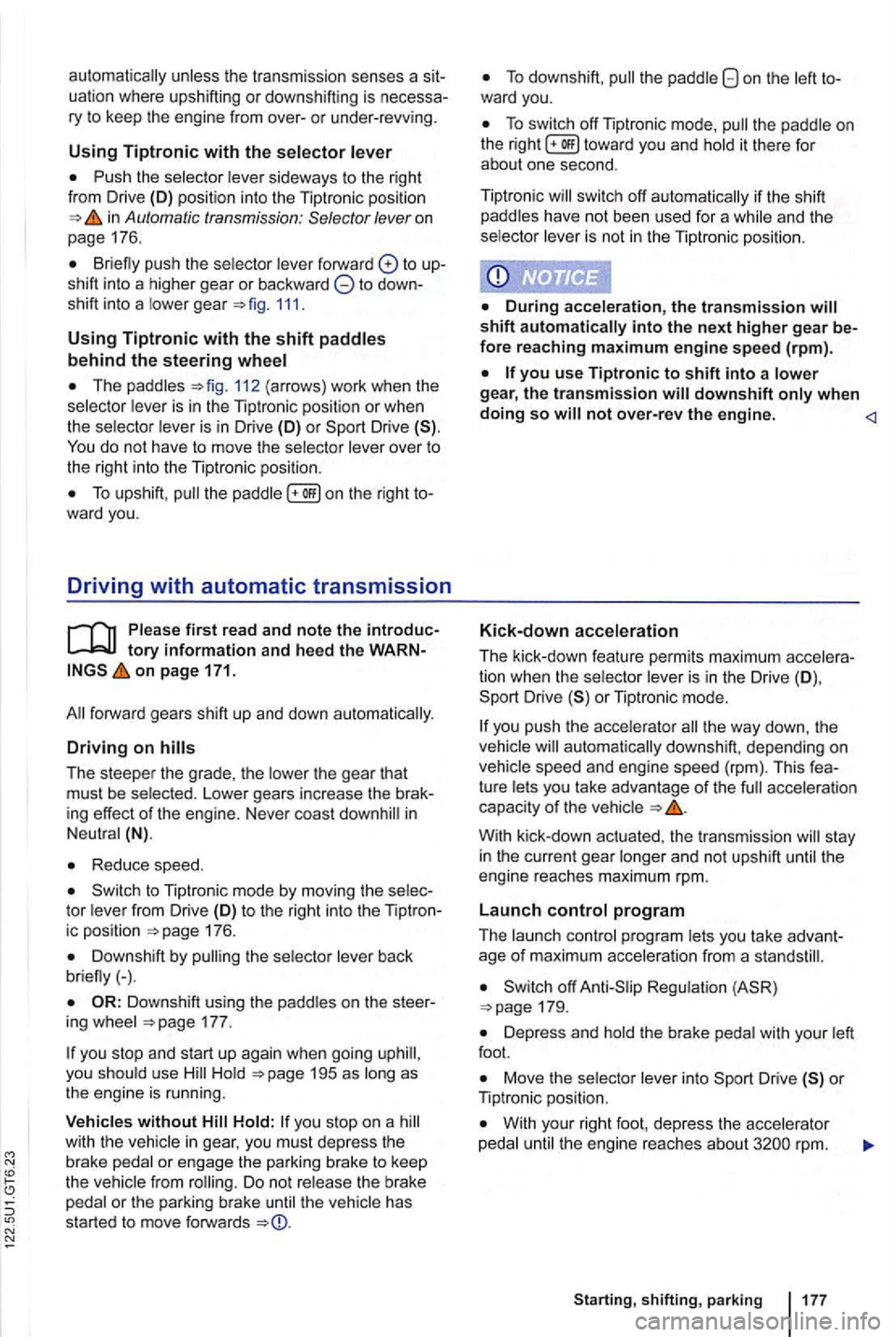
unless the transmission senses a sit
uation where upshifting or downshifting is necessary to keep the engine from over-or under-revving.
Using Tiptronic with the selector lever
Push the selector lever sideways to the right
from Drive (D) position into the Tiptronic position
in Automatic transmission :
Briefly push the selector lever forward to up
shift into a higher gear or backward to down
shift into a lower gear 111.
Using Tiptronic with the shift paddles behind the steering wheel
Th e paddles 112 (arrows) work when the
selector lever is in the Tiptronic position or when the selector lever is in Drive (D) or
To upshift, on the right to
ward you.
Driving with automatic transmission
on page 171.
in
Neutral (N).
Reduce speed.
Downshift by the selector l ever back
briefly(-).
Downshift using the paddles on the steer
ing wheel
you should use Hold 195 as long as the engine is running .
To downshift , on the left to
ward you.
To switch off Tiptronic mode,
switch off
shift automatically into the next higher gear be
fore reaching maximum engine speed (rpm).
you use Tiptronic to shift into a lower gear, the transmission not over-rev the engine.
The kick-down feature permits maximum tion when the selector lever is in the Drive (D ), or Tiptronic mode.
you push the accelerator automatica lly downshift , depe nding on
vehicle speed and engine speed (rpm). This
With kick-down actuated, the transmission
Regulation 179.
Depress and
Move the selector lever into Driv e or Tiptronic position.
With your rig ht foot, depress the accelerator
peda l until the engine reaches about rpm.
shifting, parking
Page 277 of 516
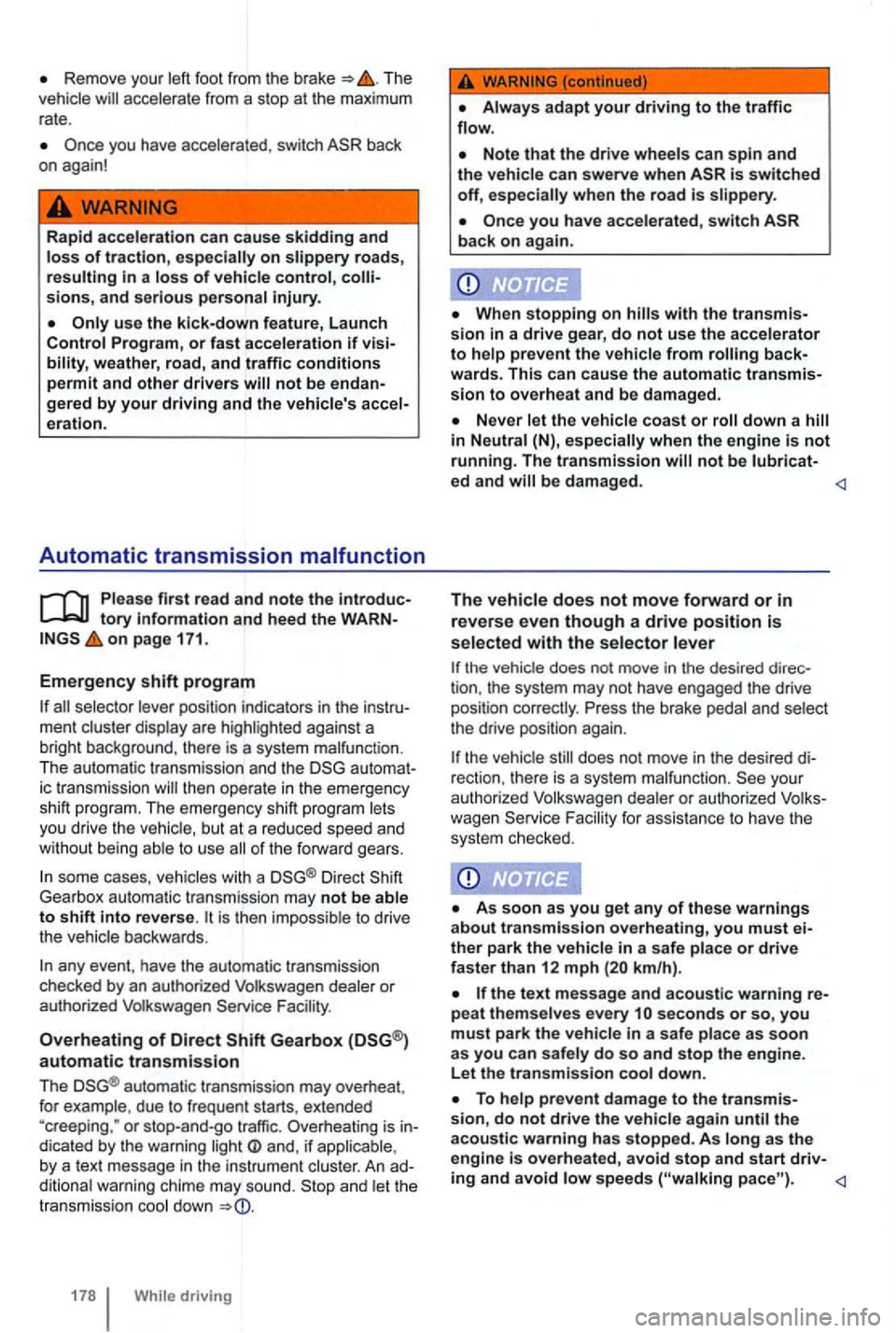
Remove your left foot from the brake => The accelera te from a stop at the maximum
rate .
you have accelerated , swi tch
weather, road, and traffic conditions permit and other drivers not be gered by your driving and the vehicle's
tory on page 171.
Emergency shift program
selec to r ment
of the forward gears.
some cases, vehicles with a Direct
is then impossible to drive
the vehicle backwards .
any event , have the automatic transmission
checked by an authorized
Overheating of Direct automatic transmission
The automa tic transmission may overheat ,
for example , due to frequent starts , extended o r stop-and-go traffic. Overheating is and, if by a text message in the in strument ditional warning chime may sound. and let the
tr ansmission coo l down =>
is switched off, when the road is slippery.
you have accelerated, switch back on again.
with the
wards. This can cause the automatic sion to overheat and be damaged.
in Neutral (N), not be lubricat-ed and be damaged .
the vehicle does not move in the desired tion , the system may not have engaged the drive
position Press the brake pedal and select the drive position again.
does not move in the desired rection , there is a system malfunctio n.
ther park the vehicle in a safe place or drive faster than 12 mph km/h) .
the tex t message and acoustic warning seconds or so, you must park the vehicle in a safe place as soon as you can safely do so and stop the engine .
L et the transmission cool down.
To help prevent damage to the sion, do not drive the vehicl e agai n until the
acoustic warning has s topped. As long as the
e ngine is overheated, avoid stop and start driv-ing and avoid low speed s pace") .
Page 283 of 516
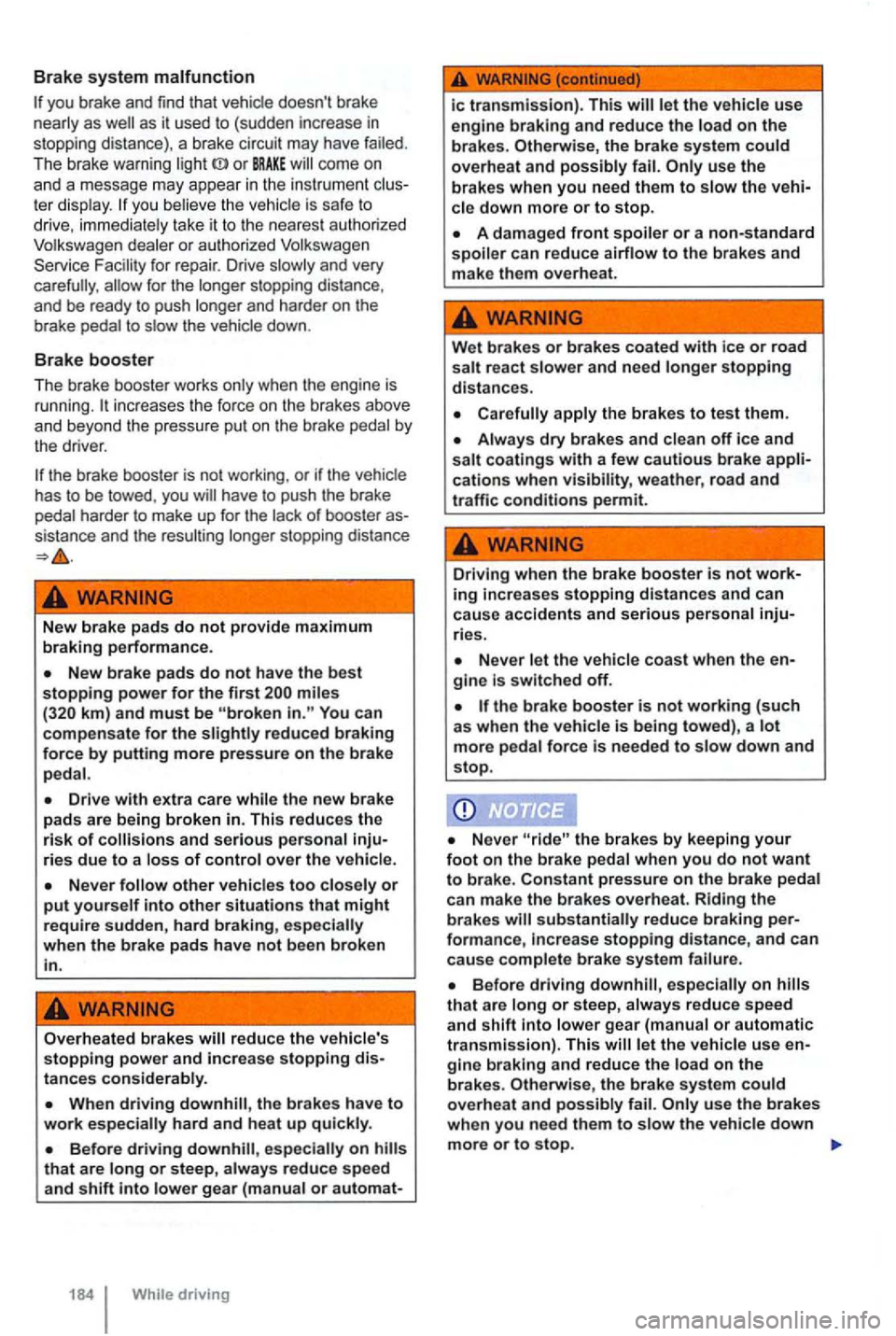
Brake system malfunction
you brake and find that vehicle doesn't brake
nearly as
come on
and a m essage may appear in the instrument ter display. you believe the vehic le is safe to
d rive, immediately take it to the nearest authorized
Volkswagen dealer or authorized Volkswagen
Service
f or repair. Drive slowly and very
carefully , for the longer stopping distance ,
and be ready to push longer and harder on the
brake pedal to slow the vehicle down.
Brake booster
The brake booster works only when the engine is
running . in creases the force on the brakes above
and beyond the pressure put on the brake pedal by
the driver .
New brake pad s do not provide maximum braking performance.
miles You can
compensate for the reduc ed braking force by putting more pressure on the brake
pedal.
other vehicles too closel y or put yourself into other situations that might require sudden, hard braking , especially
when the brake pads have not b ee n broken
in.
Overh eated brakes reduce the vehicle's stopping power and increa se stopping distances considerably.
that are long or s teep, always reduce speed
and shift into lower gear (manual or automat-
184 While driving
ic transmission). This let the vehicle use
engine braking and reduce the load on the brakes. Otherwise, the brake system could overheat and possibly fail.
A damaged front spoiler or a non-standard spoiler can redu ce airflow to th e brakes and make them overheat.
Wet brakes or brakes coated with ice or road
salt react slower and need longer stopping distances.
apply the brakes to tes t them .
Driving when the brake booster is not working increases stopping distances and can
cause accidents and serious per sonal inju
rie s.
Nev er let the vehicle coas t when the
the bra ke booster is not working (suc h
a s wh en th e vehic le is being towed) , a lot more pedal force is needed to slow down and stop.
Neve r the brake s by keeping your foot on the brak e pedal when you do not want to brak e. Constant pres sure on the brake ped al
ca n make the brak es overheat. Riding the bra kes substantially r educe brakin g performance, increase stopping distance, and can
cause complete brake system failure .
that are long or s teep, always reduce speed and shift into lower gear (manua l or automatic tran smission). This gine brakin g and reduce the load on t he brakes. Otherwise, the brake system cou ld
o ve rheat and possibly fail. use the brakes when you n eed them to slow the vehicle down more or to stop.
Page 284 of 516
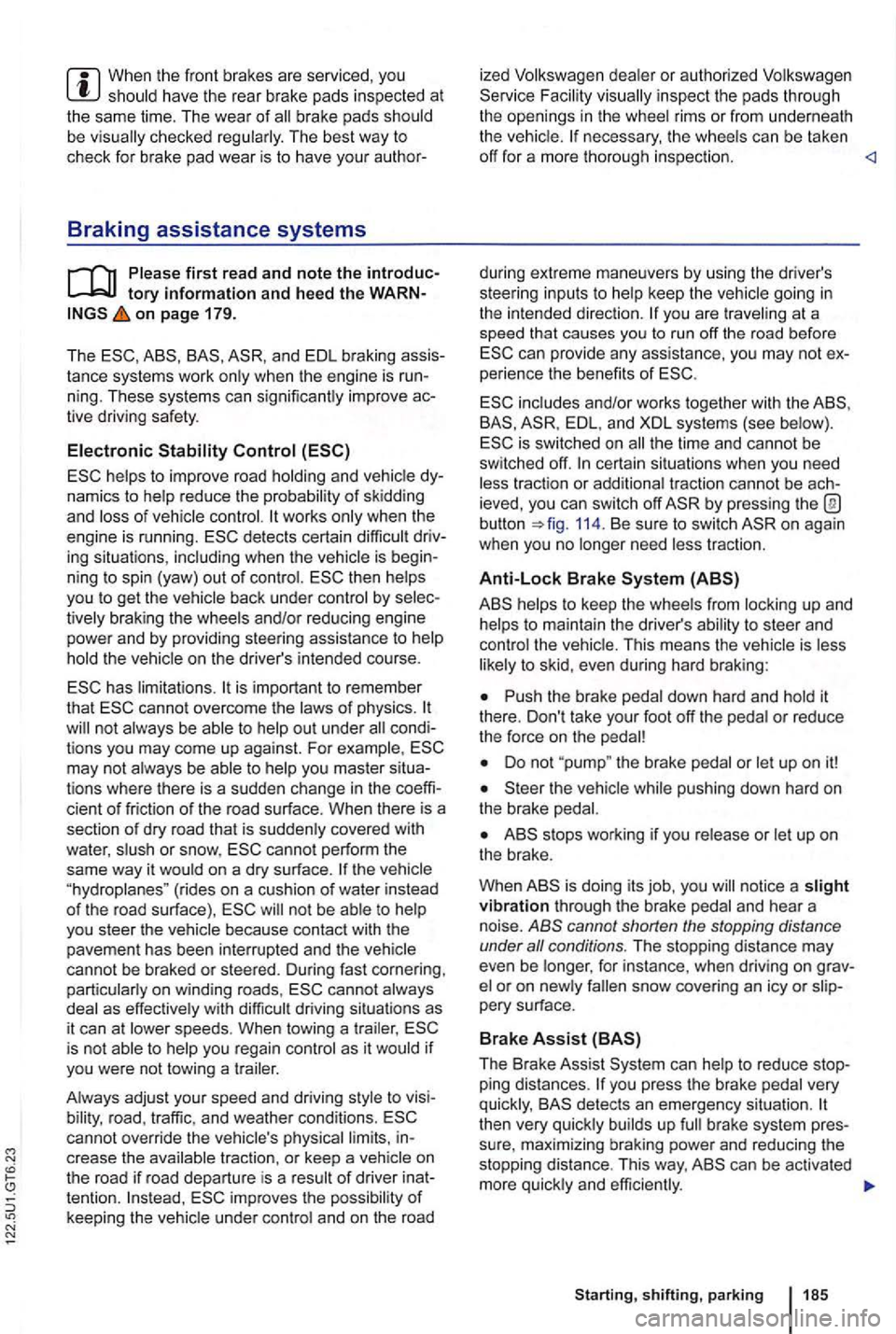
When th e front brakes are serviced , you
checked The best way to check for brake pad wear is to have your author-
Braking assistance systems
first read and note the introductory information and heed the WARNon pag e 179.
The and EDL braking assistance systems work
to improve road dynamics to of skidding and of when the engine is running . driving situations ,
you to get the
the
has of physics. not
may not be
or snow,
(r ides on a cushion of water instead of the road surface) , not be because contact with the pavement has been interrupted and the
as with difficult driving situations as it can at speeds. When towing a to if you were not towing a
to visiroad, traffic , and weather conditions . cannot override the in crease the trac tion , o r keep a
of keeping the and on the road ized
inspect the pads through the openings in the necessary, the can be taken
off for a more thorough inspection.
extreme maneuvers by using the driver's
s teeri ng inputs to
can provide any assistance, you may not experience the benefits of
and/or works together wi th the EDL, and XDL systems (see the time and cannot be switched off. certain situations when you need traction cannot be achieved, you can switch off by pressing the button on again when you no traction .
Anti-Lock Brake
to keep the to maintain the driver's to steer and the This means the is
down hard and
Do not "pump" the brake
the
notice a
cannot shorten the stopping distance
under all conditions. The stopping distance may even be for instance , when driving on gravor on snow covering an icy or pery surface.
Brake Assis t
can you press the brake very detects an emergency situation. brake system pres
sure , maximizing braking power and reducing the stopping distance. This way, and efficiently.
Page 285 of 516
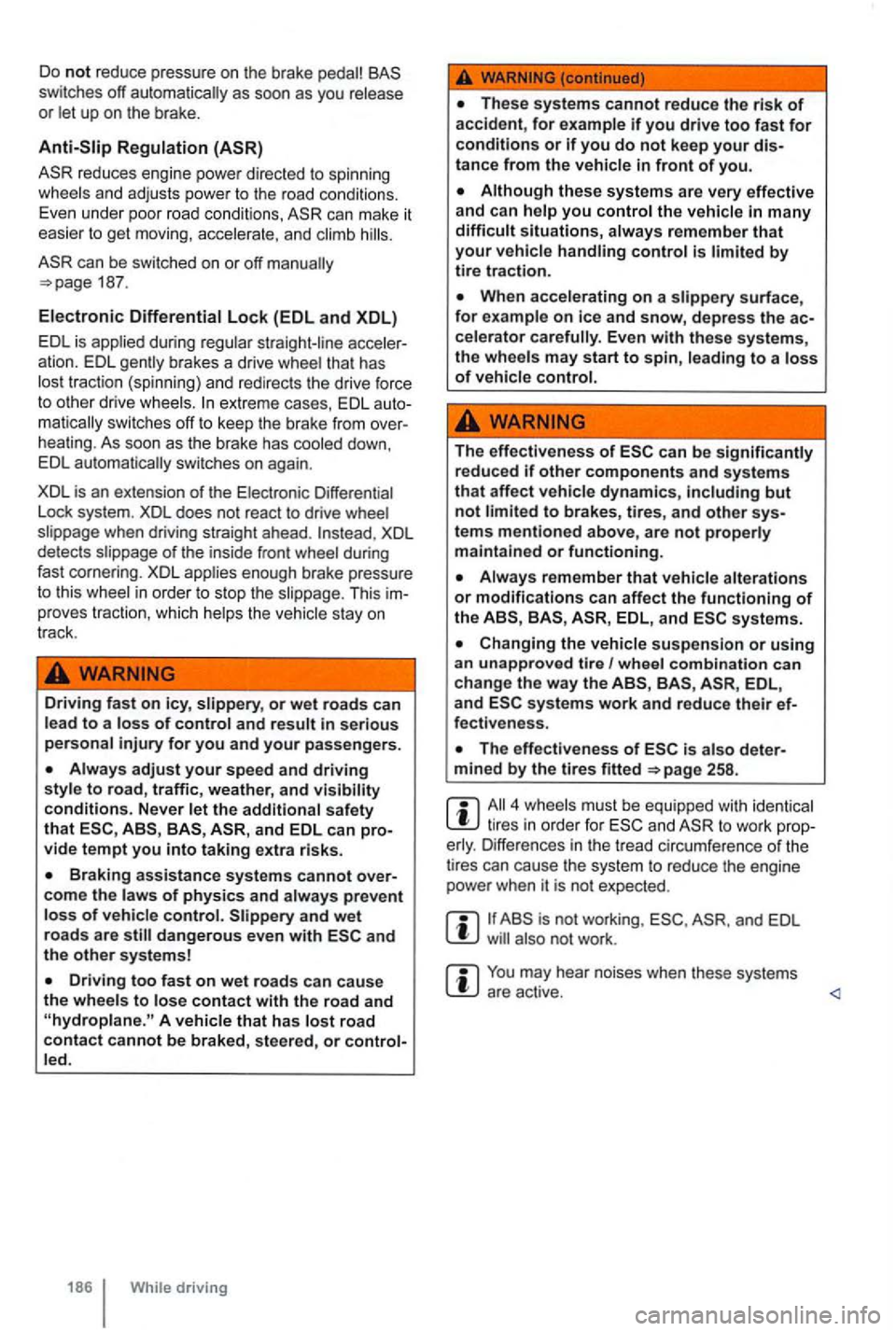
Do not reduce pressure on the brake
up on the brake.
Lock (EDL and XDL)
EDL is applied during regular straight -line
traction (spinning) and redirec ts the drive force to other drive wheels. extreme cases , EDL swi tches off to keep the brake from
switches on again .
XDL is an extension of the Electronic Differential
Lo ck sys tem . X DL does not react to drive wheel
s lippage when driving straight ahead .
XDL
detects slippage of the inside front wheel during
fast corne ring . X DL app lies enough brake pressure
to
this wheel in order to stop the slippage. This
Driving fast on icy, or wet roads can to a of control and result in serious persona l injury for you and your passengers.
Always adjust your speed and driving
style to roa d , traffic, weather, and visibility conditions. Never the additiona l sa fety that and EDL can
come the of physics and always prevent and wet
roads are dangero us eve n with and the o ther syste ms!
to A vehicle that has
1861 While driving
tance from the vehicle in front of you.
cele rator Even with these syste m s,
th e wheels may start to spin, le ading to a
The effectiveness of ca n be significantly reduced if other components and sys te m s that a ffect vehicle dynamic s, including but not limite d to bra kes , tires, and other te m s mention ed above , are not properly
maintained or fun ctioning.
Always remembe r that vehicle alterations or modifications can affect the functioning of the EDL, and systems.
Changing the vehicle su spension or using an unappro ved tire I wheel combination can
c han ge the way the EDL ,
and system s work and re duce their fectiveness .
The effectiveness of is als o
tires in orde r for and to work erly . Diff eren ces in the tread circumference of the
tir es can cause the system to r educ e the engine
p ower when it is not expected .
is not working, and EDL not work .
may hear noises when these systems are
Page 286 of 516
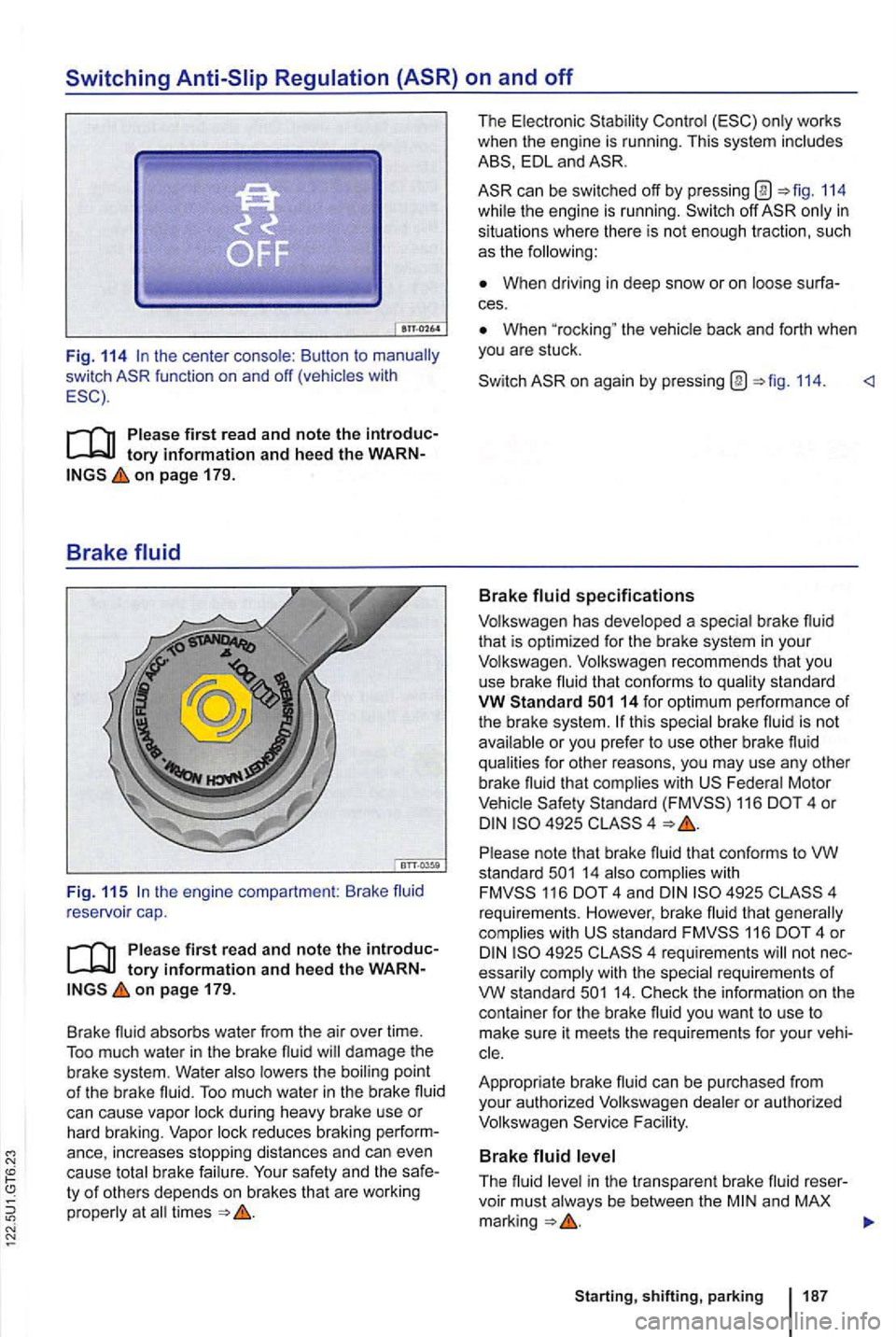
Switching
Fig. 114
on page 179.
Brake fluid
Fig. 11 5
on pag e 179.
Brake fluid
absorbs water from the air over time.
To o much water in the brake fluid will damage the brake system. Water also lowers th e boiling point of the brake fluid. Too much water in the brake flu id can cause vapor lock during heavy brake use or hard braking. Vapor lock reduces braking
ty of others depends on brakes that are worki ng
properly at all times
The Electronic
EDL and
can be switched off by pressi ng @ 114
wh ile the engine is running. off
When driving in deep s now o r on loose
When the vehicle back and forth when you are stuck.
on again by pressing @ 114.
Volkswagen has developed a special brake fluid
that is optimized for the brake system in your Volkswagen. Volkswagen recommends that you
use brake fluid that conforms to qua lity standa rd VW Standard
F ederal Motor Vehicle 116 4 o r
14 also complie s wi th 116 4 and 4925 4
requ irements . However. brake fluid that generally complies with s ta ndard 116 4 o r 4925 essarily comply with the special requirements of VW s ta ndard
cle.
Appropriate bra ke fluid
can be purchased from
you r authorized Volkswagen dealer or authorized
Volkswagen
The f lu id level in the transparent brake fluid voir must always be between the and MAX marking
Page 288 of 516

this section find info rmat ion about:
Effi cient driving sty le
....... . 189
Fue l-efficient driv in g . . . . . . . . . . . . . . . . . . . . .
Fuel consumpti on, envi ronme ntal impact, and wear
a nd tear on eng ine, brakes and tires depend main
l y on the
pe rsona l d riving style.
External conditions (weather , road condi tions).
Technical requir emen ts.
Efficient driving
on page 189.
Shifting faster
As a rule , th e app lies: The h igh er gear is
a lways the most e ffi cient gear . The rule of thumb
for mos t veh icles is to drive in 3rd gear at
mph
gears when upshifting also saves
Do not run the gea rs up to their lim it. Use 1st gear o nly to s tart movin g and then sm oot hly s hift into
2 n d gear. Avoid kick-do wns in vehicl es with auto
matic tra nsm issions.
Coasting
you take your foot off the accel erator, fuel de livery to the engine is interrupted , which lowers fuel consum ptio n.
Therefo re , whe n nearing a red stop for in
stance , the veh icle to coas t without usin g the
accelerator . Pre ss the peda l a nd release it
o nly if the vehicle mov ing too slowly or the coast
ing distance is too long. The engine
situa tions where the
swi tch off the eng in e.
conditions.
Freq uent braki ng and accelerat ion increase s fuel
cons umption significantly . Just by driving defen
s ive ly and keep ing a sufficiently large
distance
away fro m the
caused by taking your foot off the accelerator . Active braking and acceler
at ing is then not nece ssarily re qu ired .
Calm and smooth driving
Consistency is more important than speed. The
m ore smo oth ly you drive , the less fuel the vehic le
consumes.
Whe n driving
on the highw ay or free way, a co n
stant , m ode rate speed is more efficien t and eco
n omi ca l than constantly accelerating and brak ing.
you can reach your dest ination just as
quick ly by driv ing at a mod erate, but steady sp eed.
Th e crui se control syst
em can assist in mainta ining
a un iform dri vin g style.
Moderate use of extra electrical loads
Comfort in sid e the ve hicle is nic e and important ,
but it is importa nt to use the m in an envi ronm enta l
l y conscious manner.
Some devices can increase fuel consumptio n
whe n activated (exa mples):
Starting, shiftin g, parki ng 189